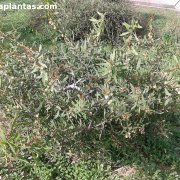Care of the shrub Hakea nitida or Frog hakea |
|
The genus Hakea, family Proteaceae, includes 150 species of shrubs and trees native to Australia. Some species are: Hakea nitida, Hakea recurva, Hakea prostrata, Hakea petiolaris, Hakea orthorrhyncha, Hakea leucoptera, Hakea laurina, Hakea cristata, Hakea bucculenta, Hakea aculeata, Hakea clavata. Common names: Frog hakea, Shining hakea. This species is native to Western Australia. They are evergreen shrubs or small trees of erect or extended bearing that reach 3 meters (9.84 feet) in height. The thick leaves are shiny pale green and up to 10 cm (3.93") long. The flowers are creamy white and appear in dense clusters in the leaf axils. They bloom in summer. The fruits are pods that have a texture similar to the skin of toads. Frog hakea is used as isolated specimens, in bushy groups, in rockeries and on dry and sunny slopes. It's ideal for Mediterranean coastal gardens. Hakea nitida grows in full sun and partial shade exposures and in Mediterranean climates. It resists light and occasional frosts. Shining hakea grows in any type of well-drained soil: sandy, stony or slightly clayey. Frog hakea is a drought-resistant plant that need moderate watering, waiting for the substrate to dry completely. Fertilize with a little compost at the end of winter. Hakea nitida tolerates light pruning after flowering to maintain a compact size. Frog hakea is a plant resistant to the usual pests and diseases but sensitive to excess moisture in the roots. Hakea nitida is propagated from seeds sown in spring or autumn in a slightly moist sandy substrate. |
Images of the shrub Hakea nitida or Frog hakea |
Find plants
Hakea nitida or Frog hakea | Care and Growing
© 2025 FavThemes

